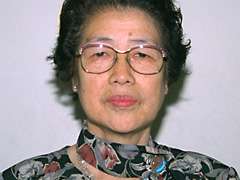Katsuko Saruhashi
| Katsuko Saruhashi | |
|---|---|
 | |
| Born | March 22, 1920 |
| Died |
September 29, 2007 (aged 87) Tokyo |
| Nationality | Japanese |
| Fields | Geochemistry |
| Institutions | Meteorological Research Institute, Japan Meteorological Agency |
| Alma mater | the Imperial Women's College of Science (predecessor of Toho University) |
Katsuko Saruhashi (猿橋 勝子 Saruhashi Katsuko, March 22, 1920 – September 29, 2007) was a geochemist who made some of the first measurements of carbon dioxide (CO2) levels in seawater and subsequently showed the evidence in seawater and the atmosphere of the dangers of radioactive fallout.
Education and professional life
Saruhashi was born in Tokyo and graduated from the Imperial Women's College of Science (predecessor of Toho University) in 1943. Then she joined the Meteorological Research Institute which belonged to the Central Meteorological Observatory (later Japan Meteorological Agency), and worked in its Geochemical Laboratory with Yasuo Miyake who became her mentor. In 1950, she started studying CO2 levels in seawater, on the recommendation of Miyake. At that time, CO2 levels were not recognized as important and Saruhashi had to develop her own methods for measuring them.[1]
She earned her doctorate in chemistry in 1957 from the University of Tokyo, becoming the first woman to do so.[2]
Results of nuclear tests at Bikini Atoll
After the Bikini Atoll nuclear tests in 1954, the Japanese government asked the Geochemical Laboratory to analyze and monitor radioactivity in the seawater and in rainfall.[2] A Japanese fishing trawler had been downwind from the tests at the time they occurred, and its occupants became ill from the effects. Saruhashi found that it took a year and a half for the radioactivity to reach Japan in the seawater.[2] By 1964, the radioactivity levels showed that the western and eastern North Pacific ocean water had mixed completely, and by 1969, the traces of radioactivity had spread throughout the Pacific. This was some of the first research showing how the effects of fallout can spread across the entire world, and not just affect the immediate area. Later, in the 1970s and 80s, she turned her attention to studying acid rain and its effects.
Death
Saruhashi died September 29, 2007 of pneumonia at her home in Tokyo. She was 87.
Awards and honors
- 1958 - established the Society of Japanese Women Scientists to promote women in the sciences and contribute to world peace.[3]
- 1979 - named executive director of the Geochemical Laboratory.
- 1980 - first woman elected to the Science Council of Japan.
- 1981 - won the Avon Special Prize for Women, for researching peaceful uses of nuclear power and raising the status of women scientists.
- 1981 - established the Saruhashi Prize, given yearly to a female scientist who serves as a role model for younger women scientists.
- 1985 - first woman to win the Miyake Prize for geochemistry.
- 1993 - won the Tanaka Prize from the Society of Sea Water Sciences.
Saruhashi was an honorary member of the Geochemical Society of Japan and the Oceanographical Society of Japan.[4]
Quote
"There are many women who have the ability to become great scientists. I would like to see the day when women can contribute to science and technology on an equal footing with men."[5]
Notes
- ↑ Yount, Lisa (1996) Twentieth-Century Women Scientists, Facts On File, Inc., p. 53, ISBN 0-8160-3173-8
- 1 2 3 Yount, Lisa (2008). A to Z of women in science and math (Rev. ed.). New York: Facts On File. pp. 263–264. ISBN 978-0-8160-6695-7.
- ↑ Robertson, Jennifer, editor (2008) A Companion to the Anthropology of Japan, John Wiley & Sons, p. 477, ISBN 140514145X
- ↑ Yount, Lisa, p. 58, ISBN 0-8160-3173-8
- ↑ Yount, Lisa, p. 56, ISBN 0-8160-3173-8
References
- Yount, Lisa (1996). Twentieth Century Women Scientists. New York: Facts on File. ISBN 0-8160-3173-8.
- Morell, Virginia et al. (April 16, 1993). Called 'Trimates,' three bold women shaped their field. Science, v260 n5106 p420(6).